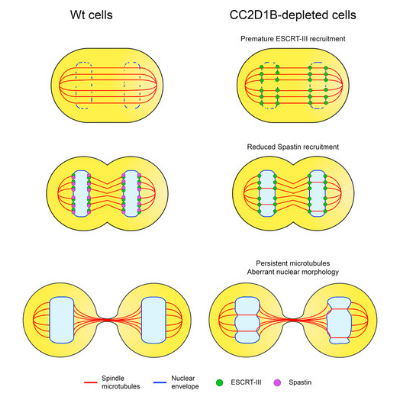Protein identified that maintains genome integrity during cell division
The integrity of the genome relies on the ability of the cells to build and maintain a well-defined boundary between the nuclear compartment and the cytoplasm, known as the nuclear envelope.
A new study, led by Leandro Ventimiglia in Professor Juan Martin-Serrano’s lab of the School of Immunology & Microbial Sciences, characterizes the cellular machinery required to organize the reformation of the nuclear envelope after cell division, providing new insights into the mechanisms used by the cells to faithfully transmit its genetic information to the next generation.
The work, published in Developmental Cell here, identified the protein CC2D1B as a key regulator of nuclear envelope reformation. CC2D1B is necessary to organize the timely recruitment of the components required to build and seal the nuclear envelope around the DNA during the latest stages of cell division. The authors observe that the lack of CC2D1B induces the formation of aberrant nuclei with altered morphology, a trait normally associated with poor cellular fitness and the development of diseases as laminopathies and cancer.
This study uncovers for the first time a molecular timer that determines the spatiotemporal regulation of the multiple biochemical activities that are involved in the reformation of the nuclear envelope.

Graphical representation of how lack of CC2D1B causes weakened nuclear envelope during cell division.
The findings open an exciting avenue to explore the molecular mechanisms involved in the reformation of the nuclear compartment after cell division. Now that it is shown that CC2D1B is a protein that plays a key role in this process, the next challenge is to understand the signalling cascades that regulate CC2D1B itself.
This study provides new insights into the mechanisms used by the cells to faithfully transmit its genetic information to the next generation. Problems with the integrity of the nuclear envelope are typically associated with laminopathies and cancer. Therefore, potential connections between CC2D1B and these human diseases will be explored.
Of the findings, Professor Martin-Serrano comments:
“Our study shows that CC2D1B acts as an essential molecular clock that coordinates membrane remodelling and cytoskeleton removal during the reformation of the nuclear compartment. These unexpected findings highlight the importance of understanding basic cellular processes, and how this type of work greatly benefits from a collaborative environment and state of the art facilities at King’s”.
Read the full paper here.